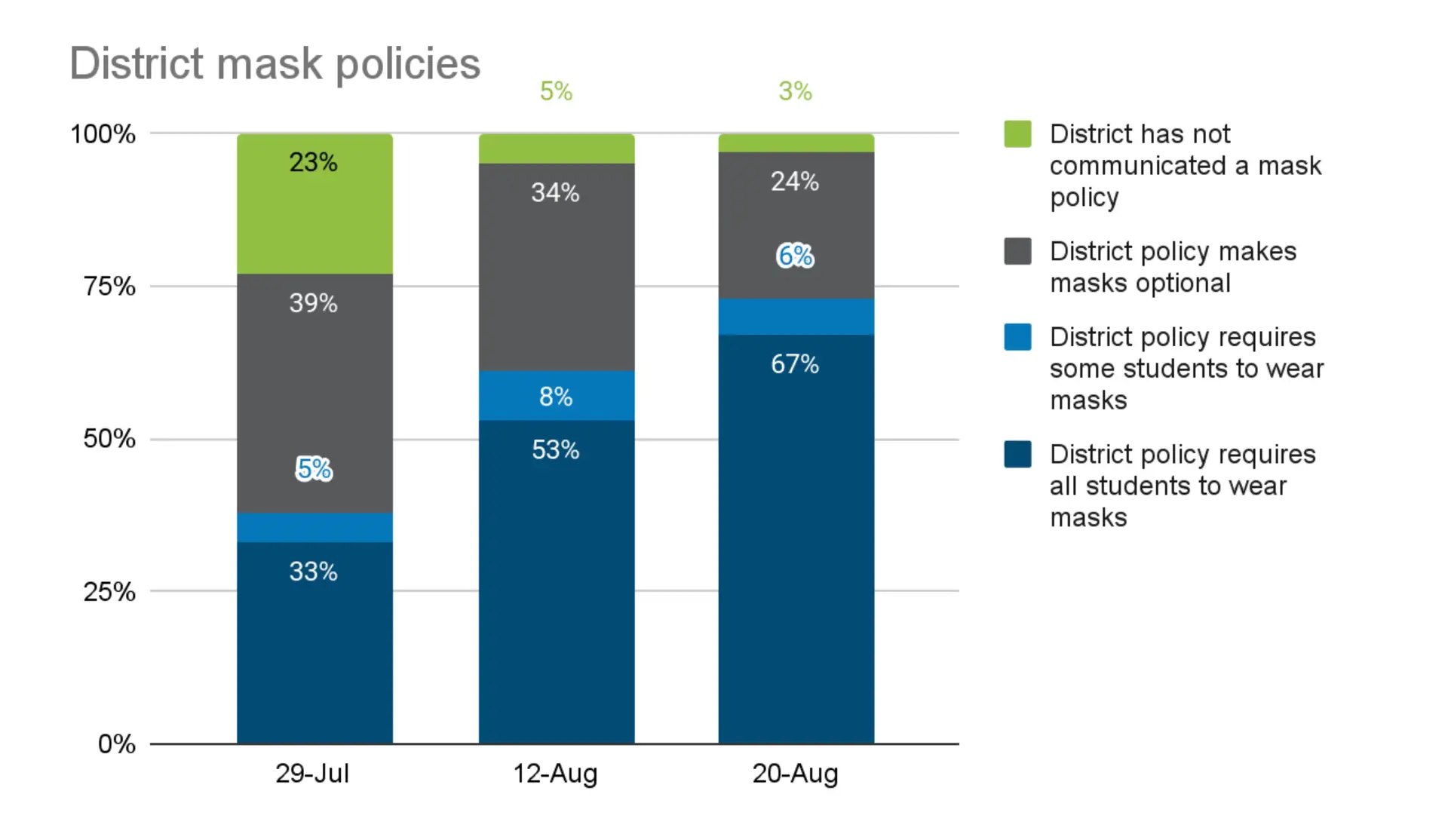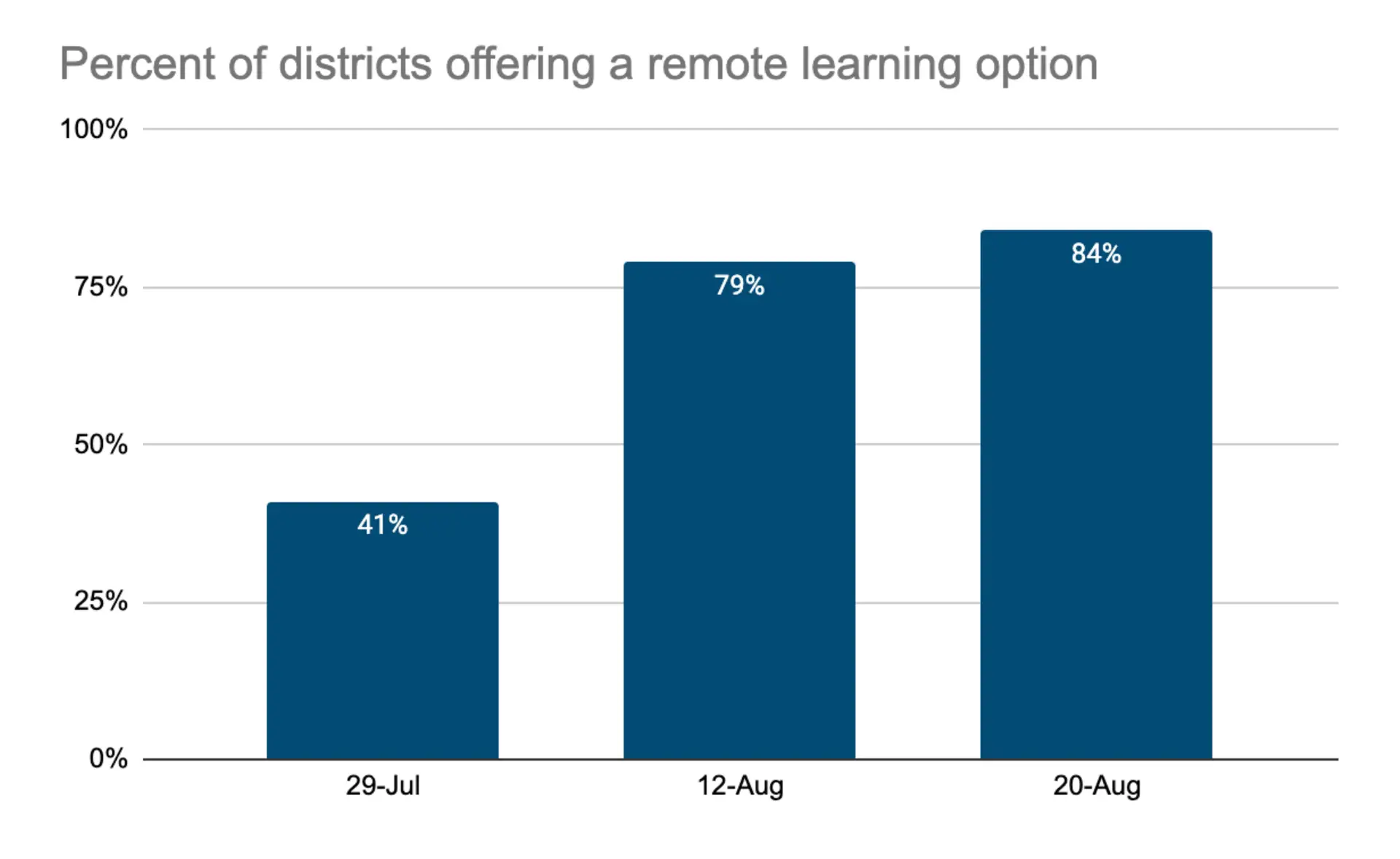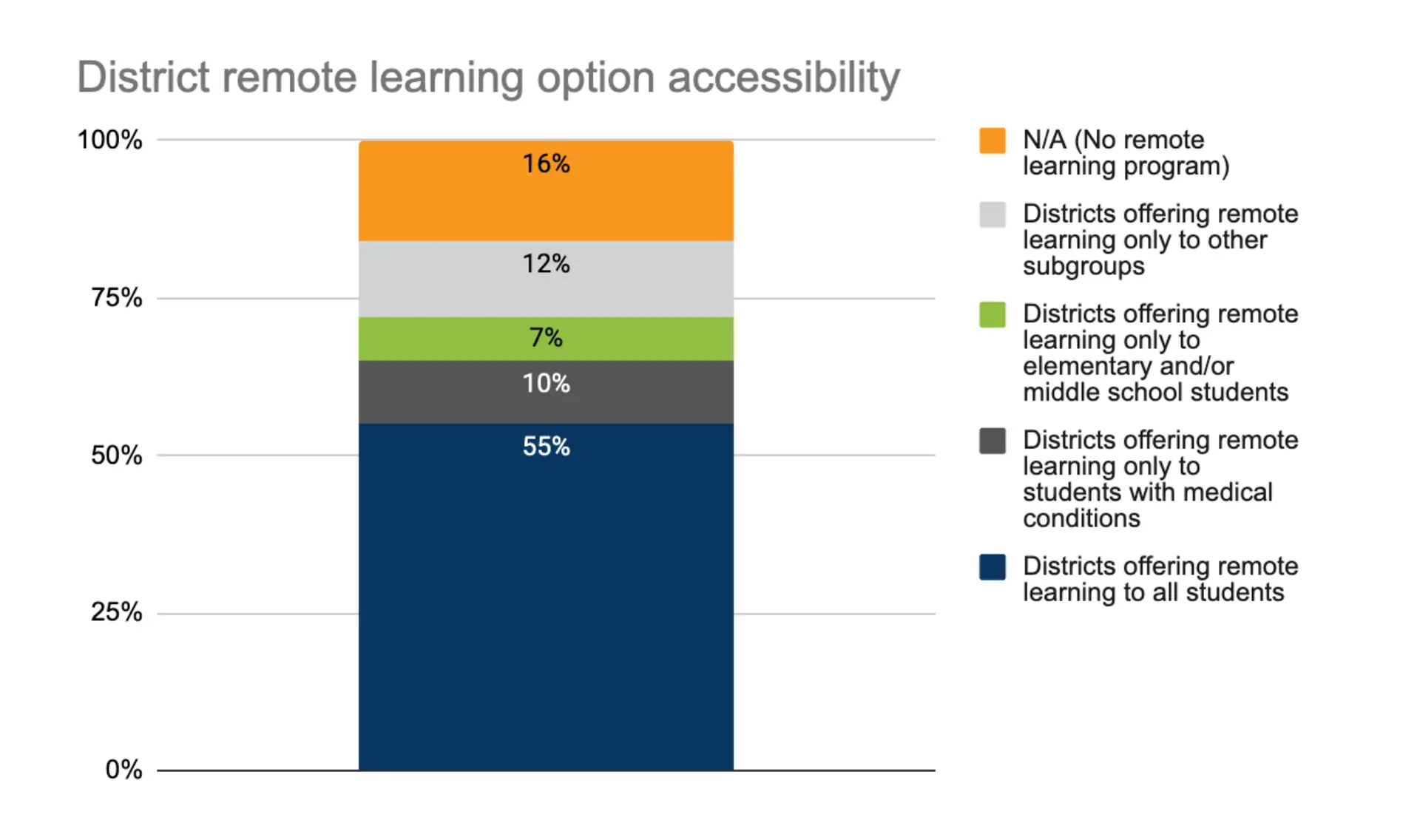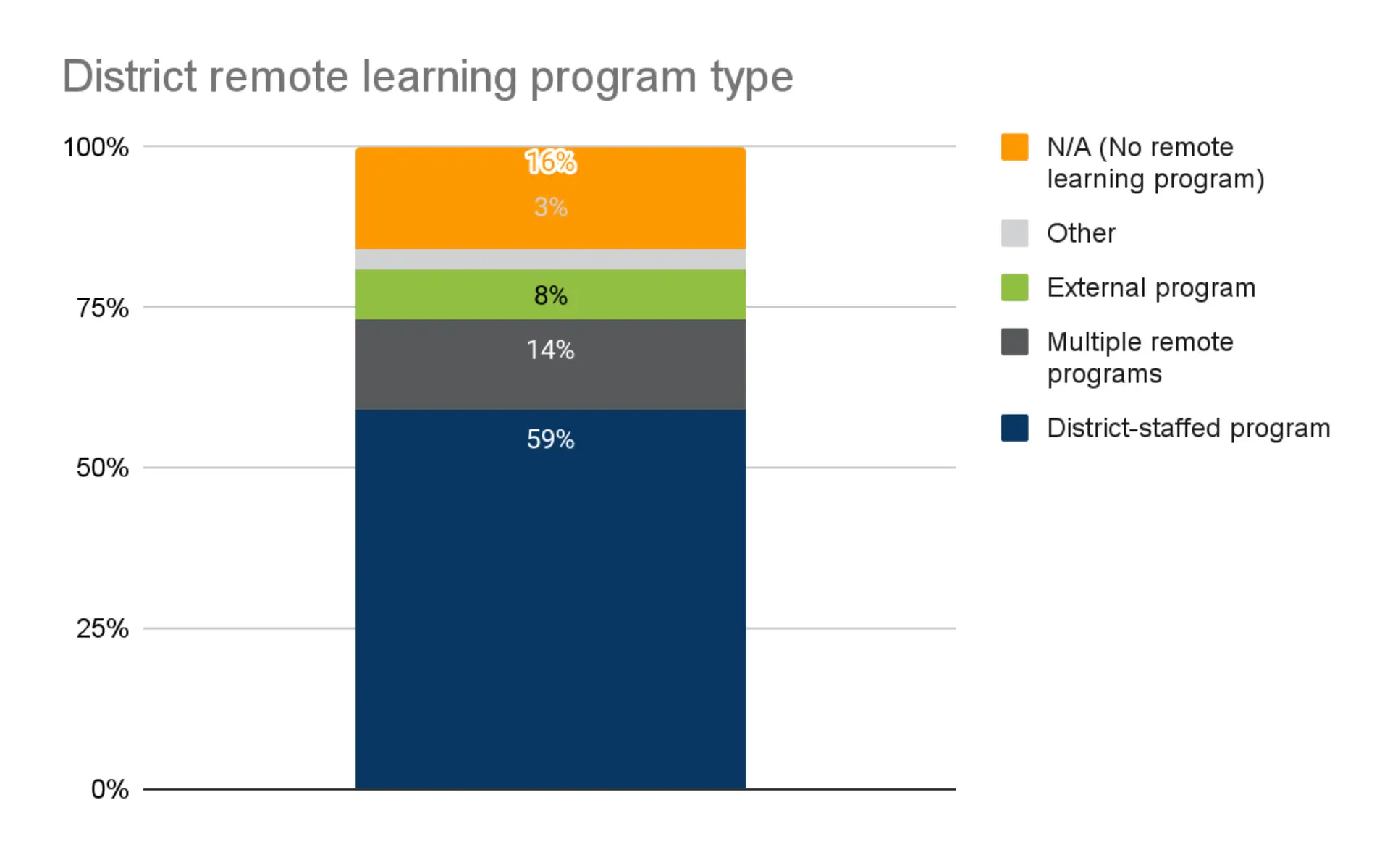Things are changing fast as the 100 large and urban districts in our nationwide review respond to the threat of the Delta variant. In the week since our last update, more school districts are requiring masks and vaccines, and remote learning plans are more detailed.
This school year, quarantine policies will be a critical issue. Details are still emerging about how districts plan to manage the interruptions as students, or some entire classes or grades, miss days or even weeks of school because of exposure to COVID-19. Ensuring those students continue learning should be job one—but it’s not clear most school systems are prepared to deliver.
Districts are stepping up anti-COVID precautions
Fourteen more districts in our review made masks a requirement this week; now two-thirds (67) require masks. Another six have mandated masks for subgroups such as elementary or preK–8 students, while twenty-four make masks optional, and only three have not shared a mask policy.
While there was no significant movement in universal staff vaccination mandates this week, two more states (Washington and Oregon) have enacted universal vaccination mandates for teachers. Of the districts in our review, thirteen have some requirement for staff vaccinations. Most of these districts are following state mandates enacted in California, Oregon, and Washington. Four—Chicago Public Schools, Boston Public Schools, D.C. Public Schools, and Denver Public Schools—have enacted local mandates. Chicago Public Schools, Denver Public Schools, D.C. Public Schools, Los Angeles Unified School District, Portland Public Schools, and Seattle Public Schools require all staff to get vaccinated. The remaining districts with vaccine mandates give teachers a choice between vaccines or weekly testing. Most of these districts are located in California, whose mandate allows for such choice.
The Hawaii Department of Education is the only district in our review that has a requirement for student vaccinations, and it only applies to student athletes. While it was not in our database, we did see a district in California (Culver City Unified School District) require a vaccine mandate for all students.
The health precaution that gained the most momentum this past week is testing. A quarter of the districts we reviewed now provide for some form of preventative COVID testing—doubling the number from last week. About a fifth (18) require testing for some or all staff. Most of the twelve districts that require just some staff to get tested, like Chicago Public Schools and California districts, require unvaccinated teachers to participate in testing. An additional seven districts offer optional testing for staff.
Seven districts in our review require preventative testing for students, with four requiring testing for all students. Los Angeles Unified School District will require all students to participate in weekly testing, regardless of vaccination status.
More districts build out virtual learning programs
We see another increase in districts providing full-time remote learning options, moving from 77 to 84 this week. Of these, the majority (55 of the 84 districts with remote learning) make it available to all students.
Students with medical or health conditions are the most common group targeted by districts with limited access to remote learning. Of the 29 districts that have limited enrollment for remote learning, 10 prioritize students with medical conditions, 7 prioritize elementary/middle school students, and 12 have other priorities (typically serving specific grade levels). San Francisco Unified School District’s virtual program prioritizes students with medical conditions, but also has some availability for elementary and middle school students.
The most common type of remote learning program, used in 59 districts we reviewed, is internally run, meaning it employs district staff. Another 8 districts offer an externally run remote program, 14 provide multiple remote learning options (such as offering an external remote program for all students and a district-staffed program for certain grade levels), and the other 3 offer a different remote option. (Two did not provide clear information and the other included a blended learning option.)
A few district options combine online learning and in-person support. Gwinnett County in Georgia offers face-to-face support to students attending its online school through “CORE Labs.” The Omaha Virtual School (the district’s only remote learning option) requires students to participate in one in-person session per week. Dallas Independent School District is launching a part-time “hybrid” school for grades four through six.
Quarantine policies: The issue to watch
Headlines across the country detail stories of dozens, hundreds, or thousands of students forced to quarantine over suspected COVID-19 exposure.
About two-thirds (67) of districts in our review have updated their 2021–22 quarantine protocol to explain whether and how students who have been exposed to COVID will be quarantined. We use the CDC’s definition of terms and count quarantine policies that apply to students who have been exposed to COVID as opposed to isolation policies, which apply to students who have been infected with COVID.
Most districts in our review (70) employ contact tracing to identify students who may have been exposed and may need to quarantine.
However, districts take different approaches to quarantine length and exemptions. Most quarantine policies are for ten to fourteen days. Anchorage Public Schools allows for up to “24+” quarantine days for students who live with an infected household member and cannot avoid continued close contact. The majority of districts are exempting vaccinated students (43 of 68, or 63 percent of districts with an updated policy), and others make exemptions for masked students (8 districts), students recently recovered from COVID from quarantines (15), or students with a negative COVID test (10).
Quarantine policies can prevent a child from accessing school for up to ten school days, each time they are exposed—creating the potential for significant interruptions to student learning. Districts in our review are typically not clear on whether or how they will guarantee continuity of instruction for quarantined students. Districts also do not appear to be following CDC quarantine guidelines, which while unclear, do recommend that masked students be exempted from quarantine—a less rigid recommendation than we are currently seeing among most districts.
Parents have a right to clear information about whether their child will have to miss school and under what circumstances. More importantly, students have a right to continue learning even if they may have been exposed to the virus. Next week, our analysis will focus on the extent to which districts are prepared to keep students safe and learning—even if they have to stay home for days or weeks at a time.










